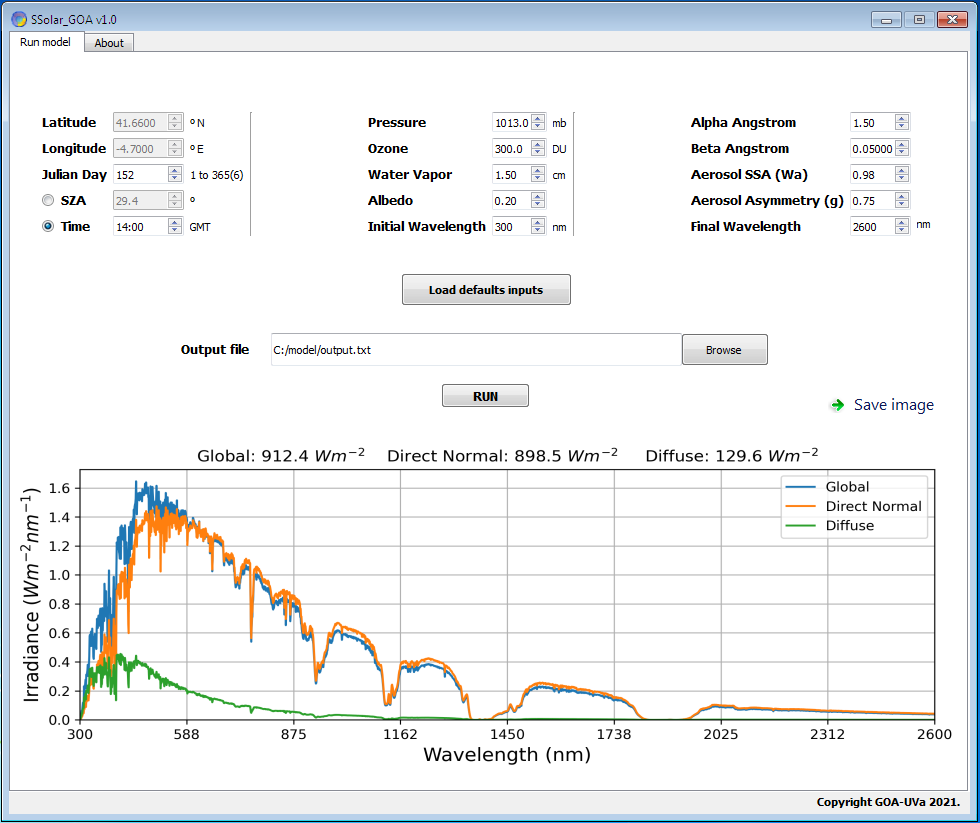
The SSolar-GOA model is designed based on our previous experience gained though using simple empirical parametric spectral solar radiation models and more complex radiative transfer codes in an attempt to cover the gap between these two extreme configurations. This is a physical, fast, efficient, and accurate spectral radiative transfer model to estimate the spectral components of solar radiation at surface level in the solar spectral range, from 300 to 2600 nm. As already mentioned, the core of the model is the simplicity of the analytical parameterized expression for the spectral scattering transmittance function of the mixed layer of molecules and aerosols. This expression was developed by Ambartsumian (Nikoghossian, 2009; Sobolev, 1963) for a one-dimension scattering medium. The atmosphere is assumed to be a single homogeneous plane parallel layer. Absorption by atmospheric gases is given by the parameterized transmittances based on “band model approach” (Pierluissi et al., 1989; Pierluissi and Maragoudakis, 1986; Pierluissi and Tsai, 1987) which were applied to the LOWTRAN7 Code (Kneizys, 1988).
The model presents a moderate spectral resolution, working very well between 1-10 nm, depending on the selected spectral resolution of the extra-terrestrial solar spectra in combination with that of the absorption coefficients of the absorbing gases. The accuracy of the model is in consonance with the error associated with experimental data of the most common commercial spectroradiometers. Below, we present a detailed description of the SSolar-GOA model, first to evaluate the direct normal component and then the global spectral irradiance, both as independent components. The diffuse spectral irradiance is derived from the other two quantities. The model, in some way, also adapts to the limited available information of the model’s input parameters.
Develop by:
Victoria Cachorro Revilla (model)
Víctor Molina García (python libraries)
Juan Carlos Antuña-Sánchez (graphic interface)
References:
Kneizys, F. X.: Users Guide to Lowtran 7, Air Force Geophysics Laboratory, United States Air Force, 148 pp., 1988.
Nikoghossian, A.: Ambartsumian’s invariance principle and some nonlinear relations in radiative transfer theory, Astrophysics, 52, 431–439, 2009.
Pierluissi, J. H. and Maragoudakis, C. E.: Molecular transmittance band model for oxygen in the infrared, Appl. Opt., 25, 1538, https://doi.org/10.1364/AO.25.001538, 1986.
Pierluissi, J. H. and Tsai, C.-M.: New lowtran models for the uniformly mixed gases, Appl. Opt., 26, 616, https://doi.org/10.1364/AO.26.000616, 1987.
Pierluissi, J. H., Maragoudakis, C. E., and Tehrani-Movahed, R.: New lowtran band model for water vapor, Appl. Opt., 28, 3792–3795, https://doi.org/10.1364/AO.28.003792, 1989.
Sobolev, V. V.: A Treatise on Radiative Transfer., Astron. Nachrichten, 287, 277–277, https://doi.org/10.1002/asna.19632870511, 1963.
